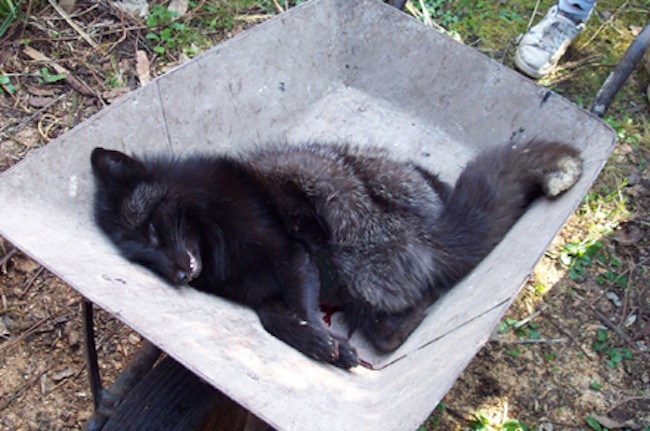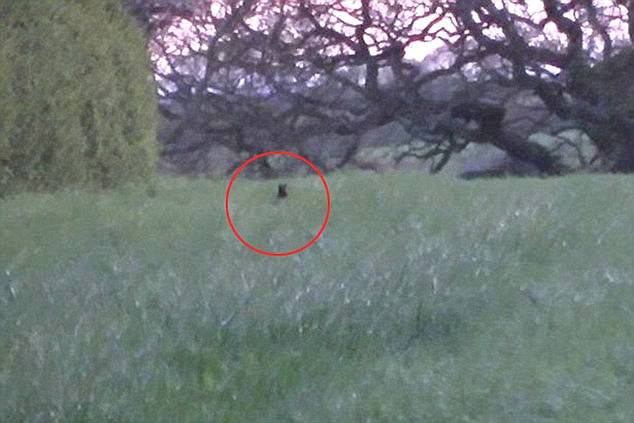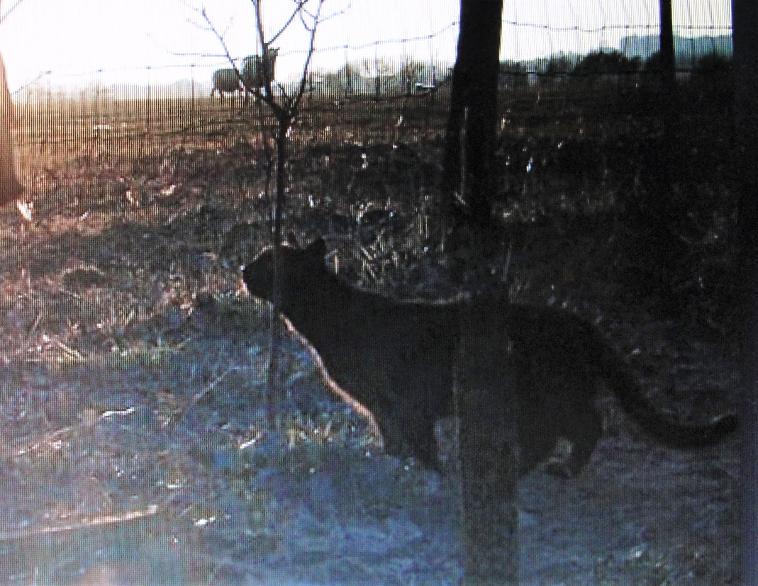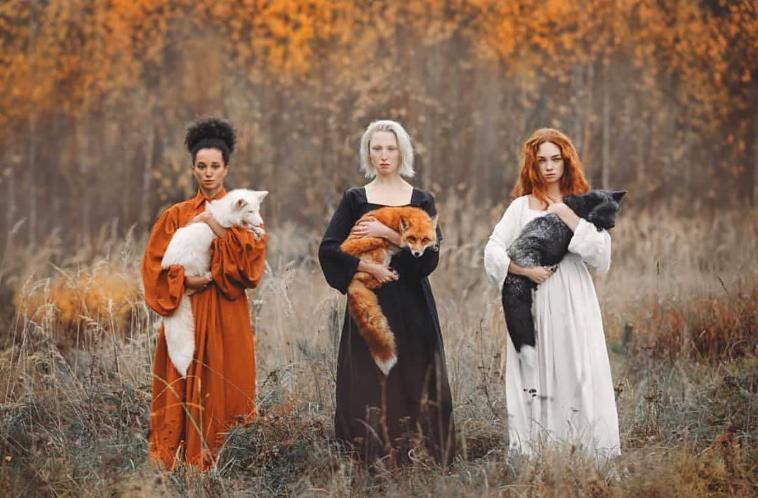
Big Black Cats & Melanistic Foxes
At Black Foxes UK, we believe it is important that the general public be correctly educated about both native fauna and captive-bred exotics. Our founder, a former zookeeper with professional experience working with lynx, cheetah, lion and serval, is well-positioned to comment as an expert in both fields. The recent media attention on the phenomenon of 'big black cat' sightings threatens to undermine our years of effort to properly educate the public about melanistic red foxes. Therefore, we kindly ask you to take note of the following.
Myths and 'British Beasts'
One notable example is the original ''Beast of Berkshire,' which was described as a sandy-coloured house cat suspected to be a wildcat (Felis silvestris), but was often misidentified by the public as a lynx (Lynx lynx), and is most likely a Savannah cat (Felis silvestris catus x Leptailurus serval). Recently, a controversial documentary about 'big black cats' has made claims to support its narrative, asserting that a black animal reported in this region is a melanistic leopard (Panthera pardus).
The documentary employs terms like "apparently" "probably" and "if" in formal reports, while using 'scare quotes' around the word 'confirms.' This language does not constitute proof and there is no available study regarding the claims of recent genetic evidence. There is no definitive way to verify whether the purported photograph and associated hair sample originates from the UK or whether it depicts a wild UK specimen. Concerns have been raised regarding the potential for the image to be Photoshopped especially as AI generated animal content becomes increasingly difficult to distinguish. The image has since been confirmed as fake, with the original source traced back to art.com in August 2023.
These two species of big cats would not typically share territory. While they can be elusive, they are not impossible to document using wildlife camera traps. Other large cats in different regions of the world, including rare melanistic morphs, often visit feeding stations regularly. Given the UK's abundant wildlife feeders and surveillance, along with active hunting communities, if such big cats were present and breeding in the UK, we would have ample evidence by now—it's currently 2024.
Nonetheless, we acknowledge the occurrence of exotic animal escapes. The foxes depicted in the image below are a relatively unknown population of black 'cat-like' animals confirmed to inhabit Berkshire. The documentary interprets reports from this area as evidence of 'big cats,' but we contend that the high frequency of sightings may actually be attributed to a growing family of melanistic red foxes.
Additionally, despite their name and the prevalence of the melanistic morph, 'silver foxes' (the domesticated North American red fox) can exhibit partial melanism, muted silvers, patterned crosses and a whole variety of other variations.
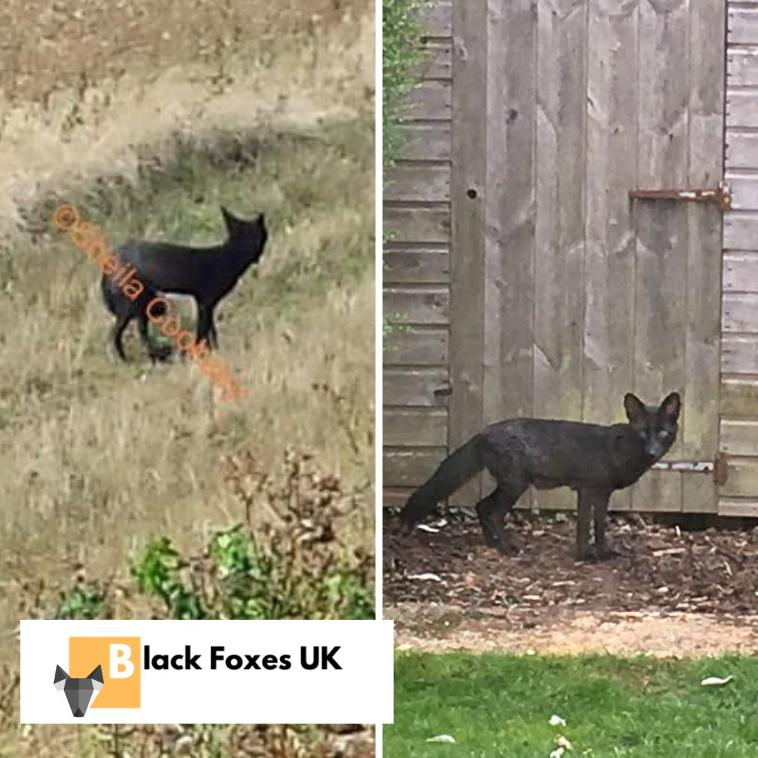
'Big Cats' and Black Foxes UK
The video below features an earlier report from when we first began documenting melanism in foxes. Our goal was to demonstrate that these sightings were likely of missing exotic pets in need of capture and return home—before any injuries occur—and to highlight that melanism in UK foxes would increase if we did not take action regarding escapees.
Ten years later, our predictions have come to fruition. Melanistic foxes, along with partially melanistic, leucistic and platinum morphs (the latter being a lethal homozygous mutation), now exist in every region of the UK. We have received thousands of reports, many accompanied by clear footage and photographs. Consequently, the majority of reports we receive today concern wild-born hybrids (European red fox x captive-bred North American red fox) rather than missing exotic pets (captive-bred North American red foxes).
The number of melanistic foxes has significantly increased beyond the initial estimate of less than 0.1% that we calculated in 2015. We suspect this figure may rise to a statistically predictable 2-8% over time, with a greater variety of colour and pattern variations observed within the UK fox population than was historically known.
The footage shows two foxes hunting in a field: one is red, and the other is melanistic. This is not evidence of a big cat; rather, it highlights a critical gap in knowledge among both the UK public and animal experts.
'Peak Panthers'
The video featured below captures a shadowy figure moving through a field—a black animal that, while not a 'big cat,' could very well be a melanistic fox. This region is notable for its high concentration of melanism within the fox population, leading us to suspect that escapees like Wilf and Kit, among others, may be influencing this trend.
Historically, it was hunts that reported sightings of these unusual foxes in the Peaks. We believe they were likely escapees from fur farms or deliberate releases of captive-bred foxes, set free for the hunt to pursue—a practice that continues to this day.
Recent media portrayals have led to public confusion, mistakenly branding known foxes as 'big cats' in Cheshire. This misrepresentation contributes to the growing population of foxes across the UK, as escaped exotic animals go unrecognised and are left to roam and breed unchecked. While many responsible keepers strive to recover their lost animals, the resources available to assist in these situations remain limited.
Silver foxes present a unique challenge, as both the non-native North American red fox and the native European red fox fall under the classification of vulpes vulpes. Currently, we lack the ability to genetically distinguish between native foxes and their hybrids from captive-bred populations in the UK. Organisations like Black Foxes UK provide valuable confirmation to officials in complex cases, yet many in the UK remain unaware of these fascinating creatures. The sensationalism surrounding 'big cats' further complicates public understanding and fosters misconceptions about the changing landscape of UK wildlife.
Silver Fox DNA Tests
UK genetic databases are lacking vital information on melanistic foxes in the UK. This makes it very difficult for melanistic North American red foxes to be accurately identified by genetic testing. Suspected hybrid foxes were tested upon our suggestion in 2021. Given their behaviour and presentation to the animal rescue, there was a high chance these were not native red foxes but red morph silver foxes or a hybrid of such. The rescue did not want to release non-native, captive-bred animals, if it were the case. The result only confirmed 'fox'.
As another example, an escaped silver fox was involved in an RTA in Bassingbourne in 2012, despite clearly being a captive bred silver fox to those who knew they existed, the animal was DNA tested and it was decided it was a fox-raccoon dog hybrid, due to the test results. This escaped silver fox was actually one of two out at the time, known to Black Foxes UK. Creating hybrids between foxes and raccoon dogs is not possible, they are different species. The incorrect result occurred because UK scientists and genetic databases lack information about the UK's melanistic foxes. The fox lived with a raccoon dog, so it is also possible it was a contaminated sample.
'Big Cat' DNA Tests
"In 2011, Durham University did DNA testing on hairs from North Devon that belonged to a leopard. That said, FactCheck at Channel 4 pointed out that Durham University confirmed the hairs “were probably from a leopard”…but there was no way to prove they were found in Devon. (Worrall 2012)
In a separate incident, DNA testing in 2012 on two deer carcasses from Gloucestershire revealed only fox DNA, despite local speculation attributing the deaths to a big cat. We suspect this may actually be a black fox, which is known to inhabit the region, thus clarifying both the results and public perception.
Furthermore, 'Operation Big Cat', conducted in 1999, coincided with the rise of foxes as exotic pets. The findings stated: "The only data on the third gene, cyt. b, are present for fox... more interesting or surprising are the results for sample 7. According to the cyt. b test, the species should be fox. However, products with both carnivore and puma primers revealed cat-like sequences. More precisely, the best fit (rank 1) of this sequence was with that of a domestic cat.. Therefore again, no indication of puma DNA. Maybe the fur sample is mixed and contains hair from fox and... cat."
Hair Raising Claims
"The laboratory has requested to remain anonymous." "Experts have concluded that if genuine it is probably the best photo of a British big cat that exists"
"The investigation in 2017 began when the Gloucestershire farmer found one of his lambs dead. Through social media, documentary filmmaker Matthew Everett got in touch with the farm and came to investigate the site. Everett’s team took swabs and sent them to Warwick University for testing, with no results."
The documentary provides no confirmation of 'big cats' in the UK and the evidence and is akin to the 'Bigfoot DNA Reveal' documentary, being debunked by several respected experts since it's release. The production also appear to be using a promotional campaign that involves placing 2D cut-outs in different locations, which we consider a manipulative advertising tactic.
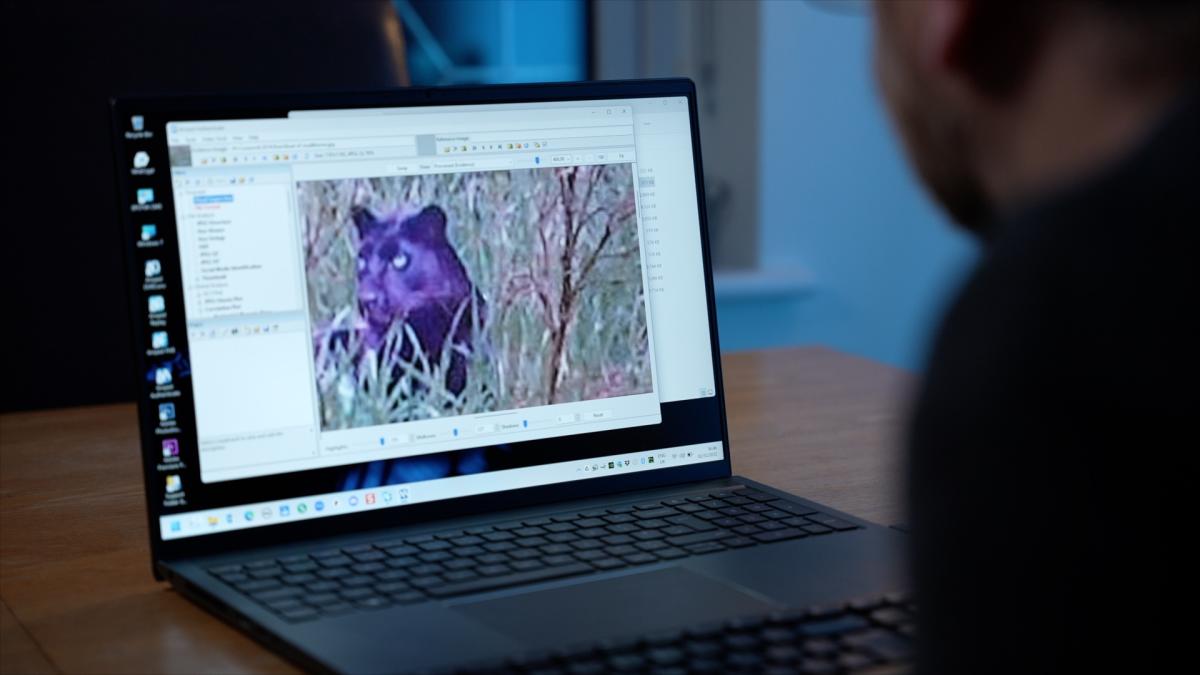
A purchased stock photograph showing a blue-eyed melanistic leopard
'Big Cats' Breeding in the UK
According to reports, "any big cats released following the introduction of the Dangerous Wild Animals Act 1976 would now be dead, unless they had bred successfully. Current sightings can only be of cats that have escaped or been released in recent years (Modification) Order 2007)." Yet, some explanations are less conventional. Burton suggests on his website Big Cats in Britain that these mysterious cats may be "close relatives of the Hound of the Baskervilles." He believes that the 'mysterious black dogs' of folklore, often seen as omens, may have evolved into the idea of big cats. So, could the 'Lindsey Leopard' simply be a result of overactive imaginations?
We believe that the extensive promotion of 'Big Cats' in the UK, coupled with a general lack of awareness about melanistic red foxes and other exotic pets, might explain why some individuals mistakenly report big cat sightings during unusual or ambiguous encounters. In reality, the elusive 'big cat' may not be present at all. It’s logical to assume that if big cats were breeding in the UK, cubs would have been seen by now. However, wildlife misidentifications are common, and what is mistaken for big cats may actually be young bovine, boar, ponies, big dogs, missing exotic cats and goats. Even the sound of ostrich or rhea and stuffed toys are often mistaken for big cats, as people search for evidence of these mythical beasts.
Several large and hybrid domestic cat breeds are legally kept in the UK without restriction (with the exception of the Serval and their F1 offspring, that come under DWA licencing requirements), though few are allowed to roam freely due to their value. These rare cats are often housed in elaborate catios or taken out on leads. When such cats escape, their unusual appearance can easily confuse people, though their owners are often quick to search for them.
Another exotic species now established and breeding in the UK, is the North American red fox. They appear to breed 'like for like' and as a result, the rate of melanism in UK foxes (as well as other colour morphs), is increasing. The increase in melanism among UK foxes can be linked to these escapees, who are interbreeding with native foxes, passing along their distinctive genetics. Much like melanistic North American grey squirrels, the presence of these exotic foxes is contributing to a noticeable shift in the UK’s wildlife.
Foxes and Folklore
There is a sort of 'cultural amnesia' over silver foxes and our use of them, indeed, there is a lot of history with the fox in the UK that we would prefer to forget. Could it be that 'devil dogs' and 'big black cats' are one and the same 'elusive black fox', that has been present in the UK since the early 1900's for breeding and could potentially have existed within the native population throughout history?
We suspect this mythical shape-shifting fox (as was common folklore throughout history; such as the fox-changing witches of Kirtlington), could also be connected to the extinct Greyhound fox; a British 'mountain fox' that once roamed our highlands. It is a large silvery 'cat-like canid' with a 'blood curdling' cry after all and sightings often occur in areas there were once UK fur farms and there was once a time we released exotic mammals to entertain the hunting elites.
Notably, the 'elusive black fox'—especially the melanistic North American red fox—has been farmed in regions where there were often sightings of both "devil dogs" and "spectral hounds." These misidentifications align with recurring patterns in folklore, where mysterious or supernatural animals are often interpreted as something more ominous. The presence of black foxes in areas associated with fur farming and elite hunting could be part of the confusion, blurring the lines between real creatures and the mythic beings of old.
Could this be the 'Black Shuck'?
Current Escaped Exotics
The trend of privately keeping large exotic mammals in the UK began in the early 2000s, after fur farming was banned and Dangerous Wild Animals (DWA) laws were relaxed. Unfortunately, there are few provisions to assist these animals when they escape, leaving organisations like the RSPCA and local authorities unprepared due to a lack of training and resources.
"The scope of the Act is being amended... to include animals not currently listed in the Schedule and also to remove those animals currently listed which are no longer deemed to present a genuine threat to the public... All of the responses to the consultation (107 in total...) favoured the Government’s preferred option... Only two responses argued there should be no species removed from the list..."
Since these species were removed from the DWA schedule, only the Animal Welfare Act offers limited protection, and few organisations are equipped to manage captive-bred exotic mammals. Foxes, especially, face even fewer protections, further complicated by the unclear legal status of captive-bred foxes.
Despite high numbers of ‘big black cat’ sightings (500-600 annually), there are far fewer black fox reports (300-400 annually between 2015-2023). This discrepancy suggests a misunderstanding, as proving the presence of melanistic foxes in the UK is much easier than confirming big cats. Escaped captive bred lynx and serval do not serve as evidence of wild big cat populations, especially since melanistic forms of these species don’t exist in the UK. Deceased and frozen animals cannot be discounted as being obtained, legally or illegally, for taxidermy purposes.
Promoting myths of wild panthers or leopards breeding in the UK misinforms the public and overlooks the real issue of escaped exotic animals. Years of research have shown that zoo and pet escapes are a far more pressing problem than the big cat myth. Escaped exotics and the refusal of some organisations to assist in their capture need urgent attention. Licensing authorities (import authorities) and private keepers must be held accountable, or these escapees may contribute to the Rewilding of Britain.
While exotic animal escapes are a concern, admixture from the North American red fox has been occurring for over a century, largely due to introductions during the 18th and 19th centuries, fur farming and exotic pet keeping.
